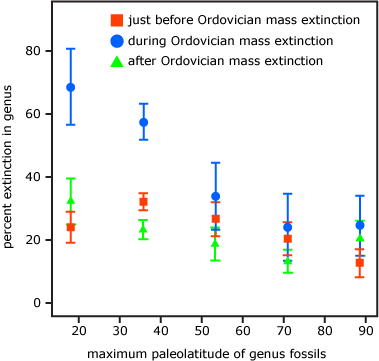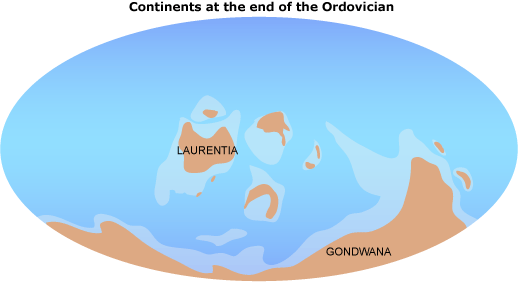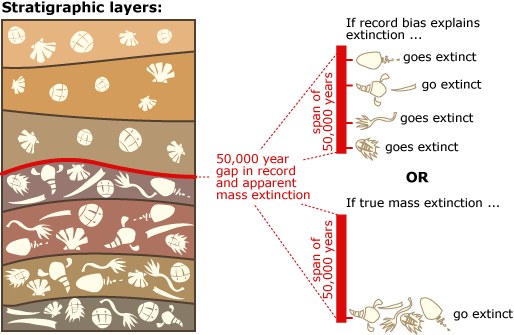
If you follow environmental news at all, you’ll be familiar with the most common cause of extinction in the world today: habitat loss. Habitat destruction threatens the survival of some the world’s most charismatic organisms — animals like the giant panda, the Sumatran tiger, and the Asian elephant. Humans have encroached on the wilderness in order to farm, mine, log, and build, and in the process, we’ve pushed the natural inhabitants of those areas into smaller and smaller refuges. Making matters worse, global climate change caused by our production of greenhouse gases is altering the environments within those refuges, forcing species to contend with new challenges. While these might seem like entirely modern problems, recent research indicates that’s not the case — and that current levels of habitat loss and climate change could have devastating consequences …
Where's the evolution?
The new research focuses on a time period around 450 million years ago — the end of the Ordovician Period. At that time, most life was marine. The world’s oceans were full of diverse invertebrates like trilobites, corals, sponges, and snails, as well as some early animals with backbones — the armored, jawless fishes. The land, which was only inhabited by a few arthropods and plants, was in a very different arrangement than today. At the time, terra firma was composed of the southern supercontinent Gondwana and a few smaller continents. The land that makes up modern-day North America was one of these smaller continents, called Laurentia. It had a balmy, tropical climate — or at least it did until 450 million years ago. Around that time, the climate began to change. Ice sheets grew on Gondwana, the cycling of carbon through the atmosphere, land, and ocean shifted, the oceans began to cool, and as more and more water was locked up in glaciers, sea level dropped and the warm, shallow seas near Laurentia drained.
Unsurprisingly, this chain of events triggered a mass extinction, the second largest in Earth’s history so far, which killed a large proportion of marine life. It’s easy to observe this mass extinction in the fossil record. Animal fossils that were common in earlier strata suddenly disappear in rocks of this age, never to be seen on Earth again. But exactly why did they go extinct? There were lots of environmental disturbances at the time, but which were the culprits? And why some species, but not others?
This interview with Dr. Seth Finnegan explains how scientists determined what caused the mass extinction at the end of the Ordovician era. This video is produced by the National Evolutionary Synthesis Center (NESCent) and UCMP.
Last month, a group of paleontologists and geologists announced the results of a study that tackled these difficult questions. Their approach was to collect masses of information about which groups went extinct and which did not and to study characteristics that members of the different groups had in common. This works a bit like trying to determine the potential causes of a disease like lung cancer. In that case, researchers would gather lots of information about healthy people and those with lung cancer in order to figure out factors (e.g., smoking or having a family member with the disease) that seem to contribute to the risk of developing cancer. The reasoning with extinction is similar, but scientists analyze factors that might contribute to the risk of extinction or provide protection from extinction.
The scientists focused on organisms living near Laurentia around the time of the mass extinction. They examined lots of information about each animal group — diet, geographic range, ability to move, etc. — however, they were most interested in testing a few specific hypotheses regarding the mass extinction:
- Habitat loss contributed to extinction. Based on the preservations of fossils in some rock layers but not others, paleontologists know that some organisms lost lots of their former habitat as the seas drained, while others did not. Does this help explain which lived and which died?
- Global cooling contributed to extinction. Some organisms have fossils that can be found in what would have been colder latitudes, while the fossils of others are only found in what would have been warm tropical waters. This indicates that some organisms were more cold-tolerant than others. Were cold-tolerant organisms more likely to survive in the cooling seas of the Ordovician?
- The mass extinction is something of an illusion that occurs because sediment was not laid down when seas drained, and hence, fossils were not preserved for a long time; this lead to the appearance of a mass extinction, but actually many organisms persisted during the sea level drop and were simply not preserved as fossils (as shown in the diagram below). Was the spike in extinction rates real or was it caused by a bias of the fossil record?
First off, the researchers determined that the mass extinction represented a real spike in extinction rates. If the apparent extinction pulse were only a byproduct of a long gap in the rock record, then we would expect longer gaps to be correlated with greater apparent levels of extinction. However, when researchers looked at rock sections with different length gaps, they found no substantial relationship between gap length and apparent extinction before the gap — so they were able to rule out the third hypothesis.
They also found strong support for the first two hypotheses: animals that lost a large portion of their habitat to climate change were more likely to go extinct than those that did not, and cold-tolerant animals were less likely to go extinct than temperature-sensitive species. So even hundreds of millions of years ago, habitat loss and climate change were major contributors to mass extinction!
Of course, the fact that these are old problems doesn’t mean that we shouldn’t be concerned about them today. Recent species losses have not yet reached mass extinction status, but if current trends continue, we will be entering the Earth’s sixth mass extinction in the next few hundred years — and habitat loss and climate change are the factors most likely to push us over the edge. Studies of the fossil record highlight similarities between past mass extinctions and processes going on today. The major difference is that while ancient extinctions were caused by unavoidable changes in Earth’s systems, the modern spike in extinction rates has been caused by human actions — and it is still within our power to turn things around and prevent a mass extinction.
Primary literature:
- Finnegan, S., Heim, N. A., Peters, S. E., and Fischer, W. W. (2012). Climate change and the selective signature of the Late Ordovician mass extinction. Proceedings of the National Academy of Sciences. 109:6829-6834. Read it »
News articles:
- A press release summarizing the new research from Caltech Media Relations
- A brief article on the topic from The Daily Mail
Understanding Evolution resources:
- A tutorial on mass extinctions
- A primer on macroevolution
- Another news brief on factors influencing extinction risk
Background information from Understanding Global Change:
- The Ordovician mass extinction is only one of five mass extinctions that have occurred in Earth’s history. Do some research on the other four mass extinctions. When did they occur and what are the suspected causes of each of these extinctions?
- Read this short review on extinction and explain the difference between background extinction and mass extinction.
- How do paleontologists detect mass extinctions in the fossil record? How could a gap in the rock record make it look as though there was a mass extinction when there was none?
- Advanced: At particular times in Earth’s history, some groups of organisms seem to have diversified quickly. How would a paleontologist detect this using the fossil record? Could a gap in the rock record account for this pattern? Why or why not?
- In the research described above, how did scientists test the hypothesis that habitat loss contributed to extinction? How did they test the hypothesis that global cooling contributed to extinction?
- Advanced: Study the graph below. Paleolatitude refers to the latitude that a fossil organism would have lived at when it was alive on Earth. Each point on the graph has error bars marked, which indicate that we are 95% certain that the true value falls somewhere inside that range. Does this graph support or contradict the results of the research described above? Explain your reasoning and how you interpret the graph.

- Advanced: Sketch a graph that would support the idea that habitat loss contributed to extinction during the Ordovician mass extinction, but was less important during times of background extinction. Be sure to label your axes and include a key.
- Teach about studying extinction in the fossil record: This research profile for grades 9-16 follows scientist David Jablonski as he analyzes patterns in the fossil record to learn about the rules that helped dictate who lived and died in past mass extinctions.
- Teach about modern implications of the fossil record: This research profile for grades 9-16 follows paleobotanist Jennifer McElwain as she studies the fossil record in order to learn more about how global warming has affected life on Earth in the past and how it might affect life on Earth in the future.
- Teach about data interpretation in evolution: This web-based module for undergraduates leads students through an exploration of the patterns in the diversity of life across planet Earth. Students are scaffolded through the exercise as they practice data interpretation and scientific reasoning skills.
- Barnosky, A. D., Matzke, N, Tomiya, S., Wogan, G. O. U., Swartz, B., Quental, T. B., ... Ferrer, E. A. (2011). Has the Earth's sixth mass extinction already arrived? Nature. 471:51-57.
- Finnegan, S., Heim, N. A., Peters, S. E., and Fischer, W. W. (2012). Climate change and the selective signature of the Late Ordovician mass extinction. Proceedings of the National Academy of Sciences. 109:6829-6834.
- IUCN. (2011). The IUCN Red List of Threatened Species. Version 2011.2. Retrieved May 1, 2012 from http://www.iucnredlist.org.


